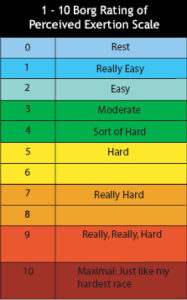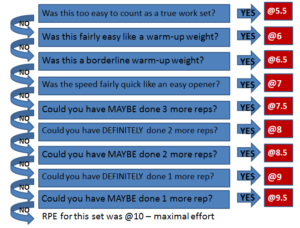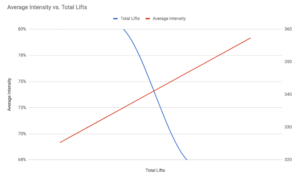Click here to download Excel file
Click here to access google drive version
Our next series of blocks will borrow quite a lot of concepts from Mike Tuscherer of reactive training systems. Mike keeps a lot of fantastic resources online and if you are interested in deep diving on programming specifically for powerlifting Mike is one of the best in the business right now you can check out his work at https://www.reactivetrainingsystems.com/Home/Main
A lot of the core concepts used in this style of programming often termed as “auto-regulatory perdosiation” aren’t new to sports science or even powerlifting. A lot of these concepts and ideas are used regularly by advanced lifters one of the original goals of RTS was to take these concepts and ideas and turn them into a systemized approach that can be used by novices or intermediate lifters to try and fast track their process.
One of the best things that RTS try and do is to remove a lot of the noise from programming and hone in on variables and landmarks that work for the individual lifter. A lot of programs and coaches claim to “individualise” but it is for the most part just a buzzword. RTS is the first approach or program I have seen outside of elite sport where teams of coaches and support staff are on hand to work with lifters I have seen an actual bonified attempt to apply the concept of individualization.
Rather than continue to talk on this subject if you want to know more about this style of programming I highly recommend you watch the following talk on programming.
We will be discussing a couple of the key ideas we will be using in the next few blocks below if you want to get to the meat of the program you can skip this upcoming portion of this article.
Rate of Perceived Exertion (RPE).
RPE has been around for several decades it has been used in a number of programs and sports before it was brought into powerlifting. Typically it is used to track gross load in a sport such as rugby or football where athletes take part in a lot of different modalities such as conditioning, weight training, sports training, and competition. Some of the commonly used scales include the Borg scale.
As you can see the Borg scale is aimed at endurance training and as such isn’t completely ready to be used for lifting. It was adapted to lifting as a way of putting subjective feelings such as “Fucking smoked that bro” into some kind of objective and useable measure to allow a lifter to conceptualize and to adapt their training loads.
RPE for lifting –  Above you can see a chart adapted by powerliftingtowin.com which takes the RPE 1 to 10 scale and puts it into a lifting context. Common nomenclature used in the same context as RPE is reps in reserve (RIR). Basically, after a set, a lifter can say how many reps they had left in the tank these two rating systems are essentially the same thing. RPE can be put in another context (the difficulty of the lift) as in you can perform a single on a weight and have weight in reserve but maybe not have another rep in the tank.
Above you can see a chart adapted by powerliftingtowin.com which takes the RPE 1 to 10 scale and puts it into a lifting context. Common nomenclature used in the same context as RPE is reps in reserve (RIR). Basically, after a set, a lifter can say how many reps they had left in the tank these two rating systems are essentially the same thing. RPE can be put in another context (the difficulty of the lift) as in you can perform a single on a weight and have weight in reserve but maybe not have another rep in the tank.
For instance, let’s say you have a 1 rep max of 200kg. We are looking to perform a set of 7 @ RPE 7 or with 3 RIR.
As a guide weight we can look at your predicted 10 rep max of 75% this would give us a working weight of 150kg
Once you perform your set you reflect back on the difficulty of the set you could come to the following conclusions
150×10 – felt easier than expected I will rate that @ 6 RPE or I will rate that as 4 reps in reserve (RIR)
150×10 – felt as expected. 7 RPE or 3 RIR
150×10 – felt heavier than I expected I will rate it as @ 8 RPE or 2 RIR
It’s not an exact science but it is a very good way of allowing a lifter to take more control over there loading and it is more sensitive to the lifters recovery and state of preparedness. This allows them to take advantage of when they are feeling good and allows them to take it easy when they are feeling like shit.
Emerging Strategies
One of the key concepts in this style of training is to strip away variables to allow you to see some key bits of information
- What intensity zones you respond best to
- How many workouts you can improve upon in a row (time to peak)
- What volume you can recover from
- What exercises you respond best to
This is done basically by choosing a variable you want to look at over the next period of time and then just repeating the same workout taking notes of load, volume and subjective feelings of recovery or objective measures of recovery such as heart rate variability.
Over the next 2 blocks, we will be singling out two intensity zones moderate (5s) and Heavy (3s). By sticking to the suggested RPEs you should not lead to being under recovered or overworked. It will also give you some good information on how many workouts in a row you can improve upon from week to week.
By reducing the variability in loading, exercise selection and frequency you can pick up the signal as in you can see how you are responding to set variables.
The Program
- 4 days a week.
- 2x squat days
- 2x deadlift days
- 4x pressing days
- Core and back assistance
- A moderate volume of work
- A linear increase in intensity week to week
- RPE suggested allowing autoregulation (the program will change work out to work out based off how you are progressing).
- Competition specific variations and pause variations to keep it specific. More variety in pressing to reflect higher frequency of work.
Volume and Intensity
| Week | 1 | 2 | 3 | 4 | |
| Total Lifts | 360 | 360 | 320 | 320 | |
| Average Intensity | 69% | 73% | 76% | 79% | |
This program is more simple in terms of layout as it is essentially a linear program of flat loaded 5s but the introduction of RPE and reduction of variables should give you some new ideas and give you some good information for future design of programs.


